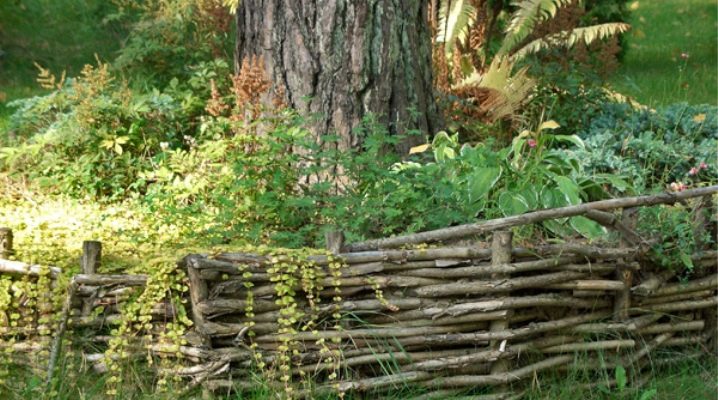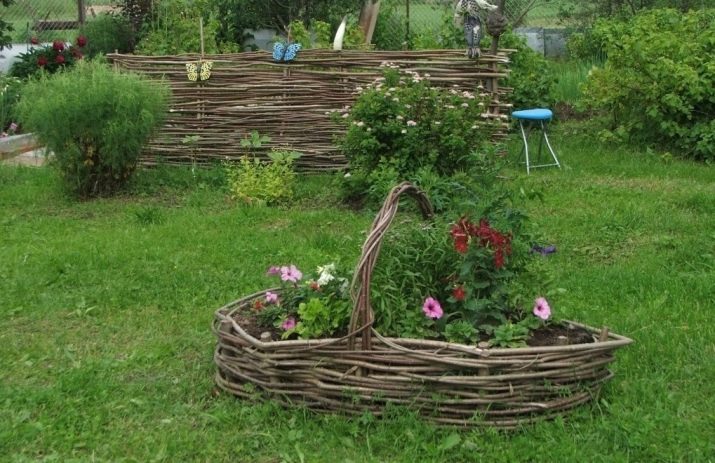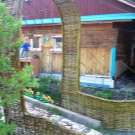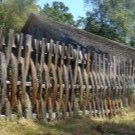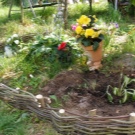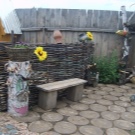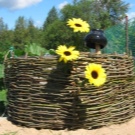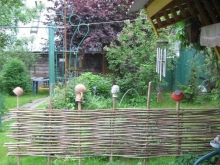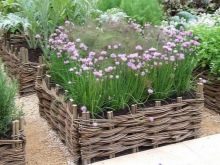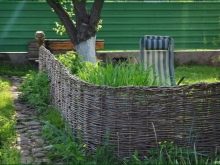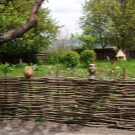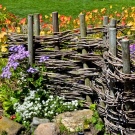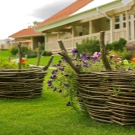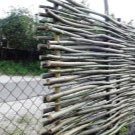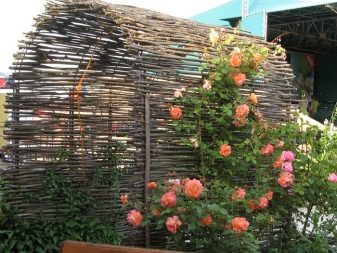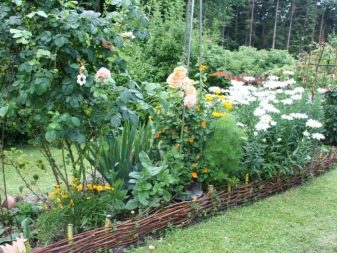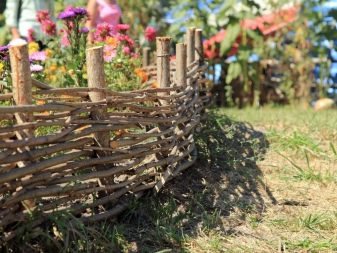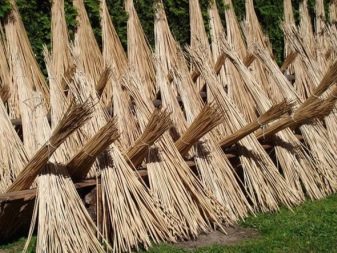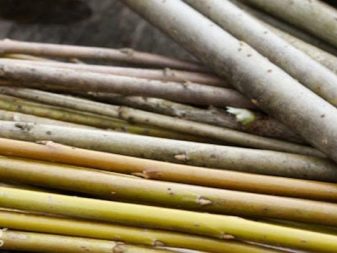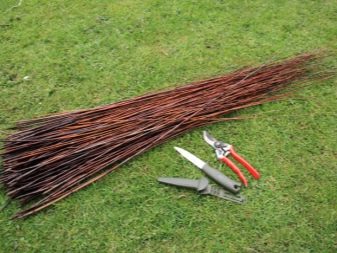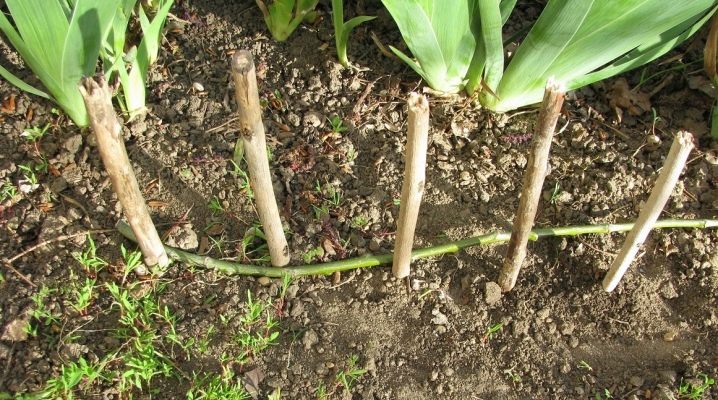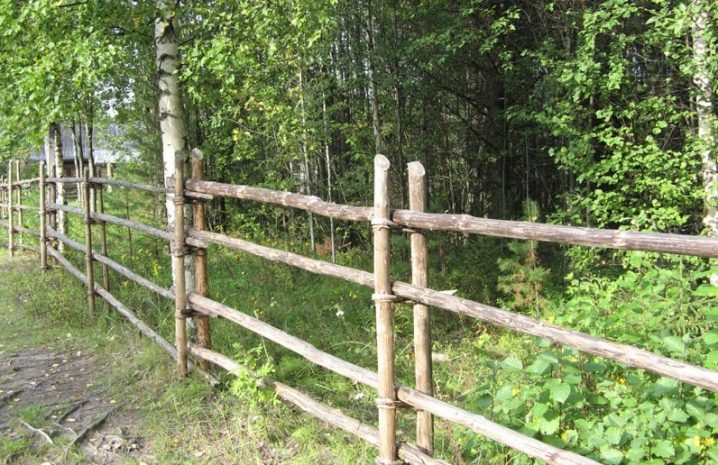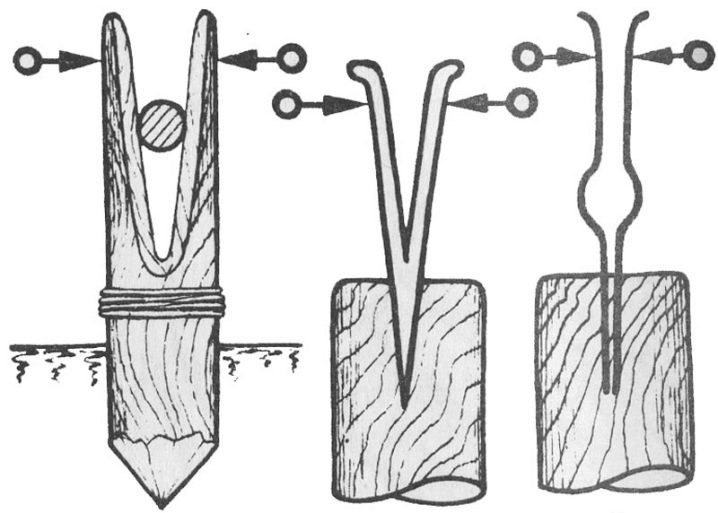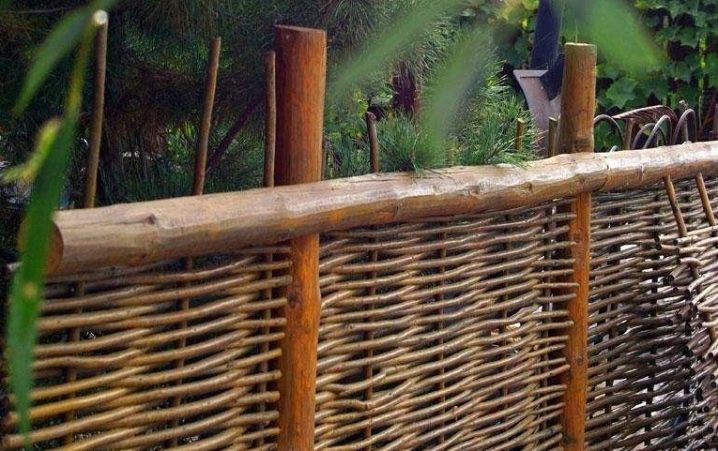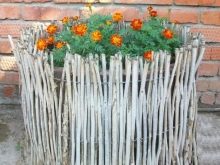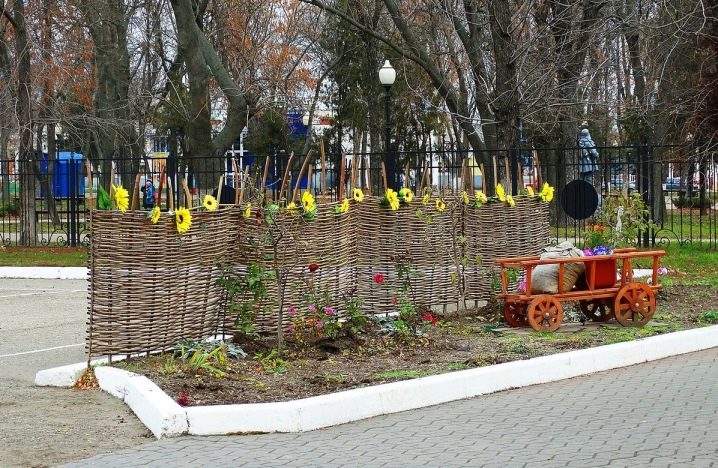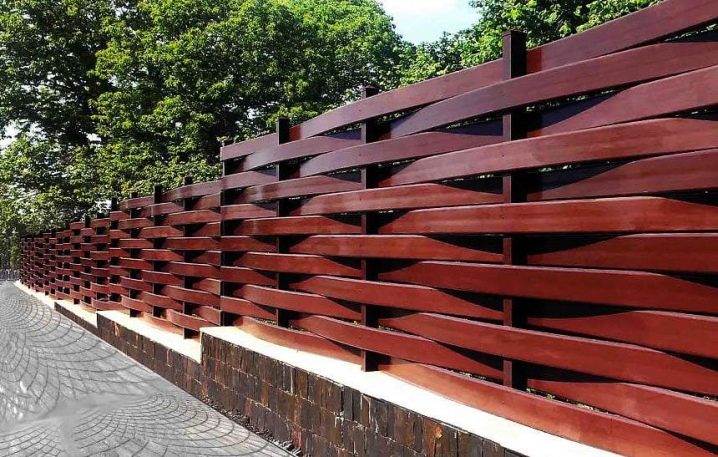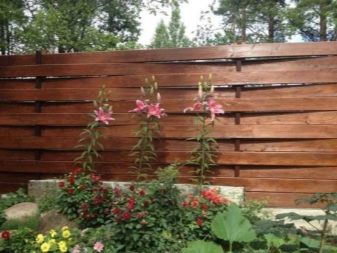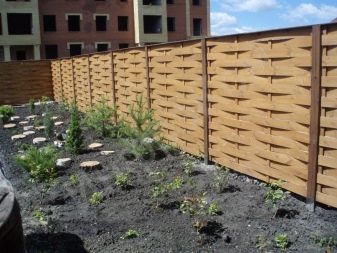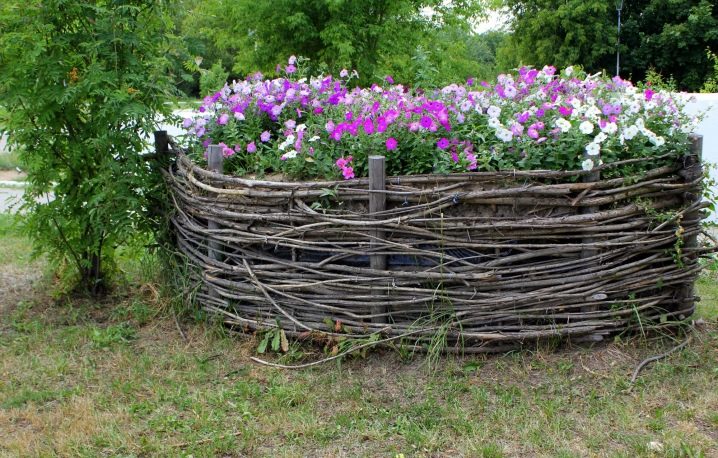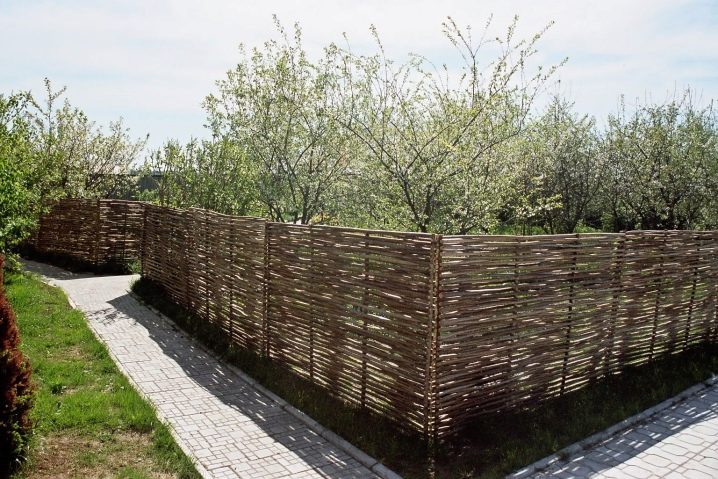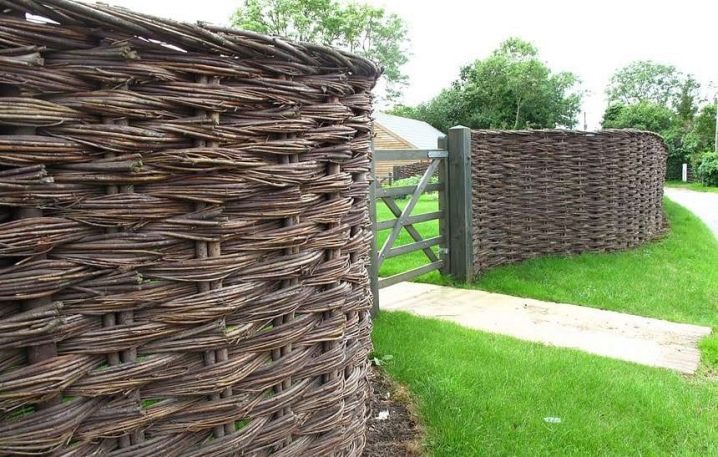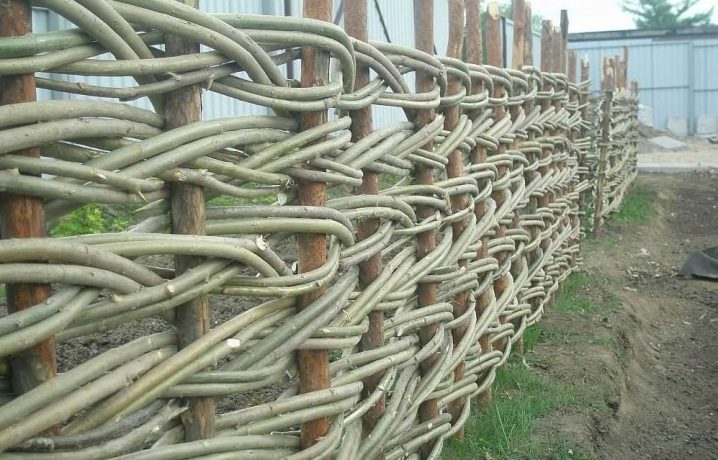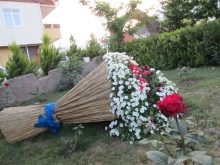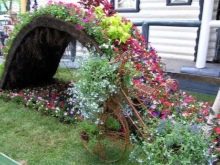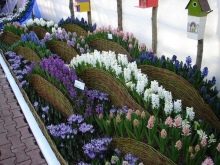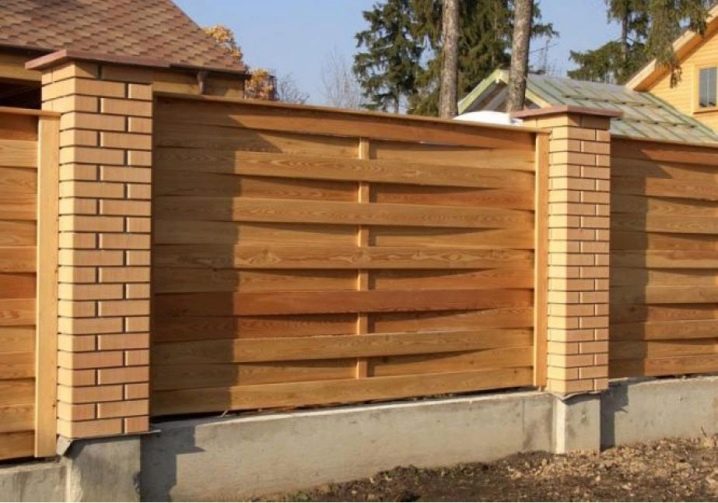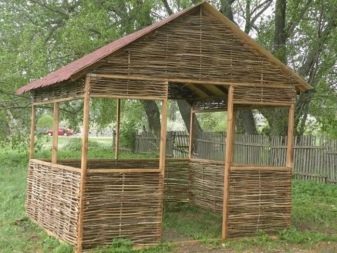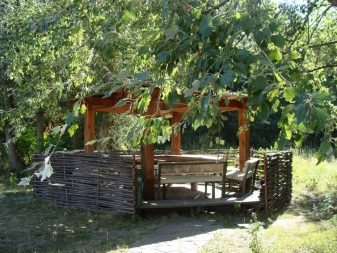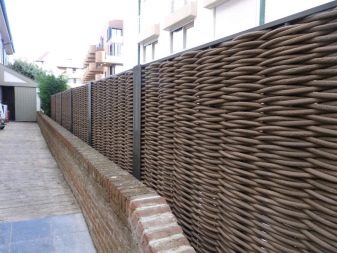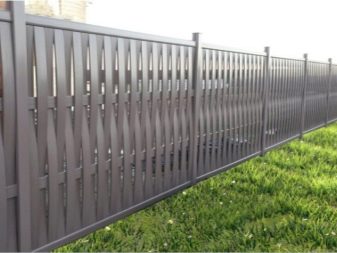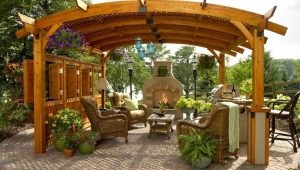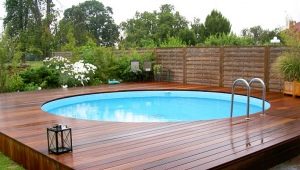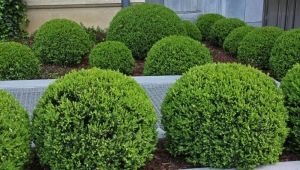Wattle: beautiful examples in landscape design
From the point of view of modern man, wattle is an archaic attribute. Such uncomplicated fences, firmly associated with rural life, have long been replaced by strong, solid, reliable fences. But the braided type of fence has acquired a new meaning over time, having turned from a household tool for demarcating the territory between neighboring houses into a colorful decorative element, which designers actively use to decorate a flower bed or flower garden and visual delineation of areas.
Such a wicker fence is quite simple to make independently from scrap materials. This activity can also bring a lot of pleasure to a person with creative thinking and skillful hands.
Features a wicker fence
It cannot be said that for wattle there is a place exclusively outside the city, for example, in a country house or in a village.Such a decorative fence with its uncomplicated country view will look good in the design of the flower bed at the city’s five-storey building, which is co-occupied by residents. There will be a place for him in the territory of a kindergarten or near a summer cafe in the city center.
This fence has a number of advantages:
- As a rule, it is made from natural material, which is important for additional environmental friendliness in the process of contact with the fence.
- The product is very easy to install.
- If necessary, the fence can be assembled and reassembled again.
- Such a fence gives plenty of room for original design solutions.
- In addition to the branches of trees and shrubs for its manufacture, you can use some modern materials, for example, thin PVC pipes.
Among the disadvantages of a wicker fence are the following signs:
- The design is short-lived.
- Such a fence is not a capital building, carrying the function of protection.
- The complexity of the repair. In case of damage, a significant part of the fence will have to be twisted.
A rather reliable stopper in the path of outsiders can become a fence, reaching a height of two meters.If you make stone pillars and install between them wicker sections of the vine, such a fence can be considered impregnable.
To delimit the territory, you can set the fence about a meter high. The children’s playground with swings will seem very comfortable for the children if you isolate them from the noisy street with the help of such an interesting fence. Wattle half a meter is well suited for "labeling" and emphasizing the beauty of the flower bed.
To create a fence suitable flexible branches. The most short-lived is the reed, which can last a maximum of four years. Then it dries, which will lead to the rapid destruction of the fence. The fence from boards or PVC will become quite reliable construction.
Horizontal fence is more reliable than vertical, but you can create complex and intricate patterns, intertwining vertically mounted branches.
Preparatory work
Creating a fence you need to attend to in advance. In order not to harm trees and shrubs, the material is advised to harvest in January. Choose flexible branches with a length of at least half a meter. The thickness of the blanks should be one to two centimeters.To have a lot of room for creativity, it is good to stock up with branches of different colors.
Before starting work, the foundation of the future wattle is soaked. It is necessary to make sure that all the branches are completely in the liquid. Soaking can last at least a week. If they are cut off quite recently, two or three days will suffice.
The most common material for wattle are birch, willow, walnut, apple. But to dwell only on these species of trees and shrubs is not necessary. Wicker fence will work well from the branches of various trees, if they are flexible. As a rule, branches of shrubs and trees growing near water bodies have such properties. They usually have a smooth surface and a large supply of moisture inside.
Reed, unlike the vine, should be harvested in August. This process can be extended until October. To achieve a certain design effect, it makes sense to weave a straw fence. For this, rye is best suited. With careful soaking, it remains flexible and resilient. Despite the fact that rye straw and so beautiful color, it can be repainted in any.For this fit aniline dyes.
How to make your own hands: a master class
In order to create the weave itself, you need to decide on the installation location of this fence and the material from which it will be woven. You can do it simply by harvesting a vine from what grows in the area — hazel, willow, acacia, aspen, and other trees and shrubs.
At the chosen place make the basis of the future wattle. To do this, you will need stakes (pillars) that need to be driven into the ground to a depth of at least twenty centimeters, but in order for such a fence not to fall down exactly, and your work will not be in vain, it is better to ground these supports half a meter. To facilitate the work, you can use scrap, with which it is convenient to make holes for stakes.
In diameter, the pegs themselves must be at least five centimeters. The preferred option is larch. Although plastic and metal supports are suitable for the base, fittings or PVC pipes will be useful. It is convenient to paint them in the desired color.
If they are empty inside, it is better to make them plugs, which will serve as a guarantee that the basis for the fence will be durable.
Wooden pegs are better treated with antiseptic, paint, varnish, so that they do not rot. Sites of cuts are recommended to be burned and impregnated with an antiseptic.It is also possible to hammer plastic pipes of the required size into the ground before installing them, and to insert wooden supports there. This will allow the fence to serve for a long time, as it will prevent the process of rotting wood in the ground.
The distance between the elements of the base should not be more than half a meter. It would be rational to place the supports in thirty to forty centimeters without sparing the material. The rods themselves, like the pegs, can be painted in the desired color. To do this, and suitable conventional paints and dyes of vegetable origin. It is possible to give a fence a yellow shade thanks to the husks of onions, birch leaves, brown is created with the help of black alder. For staining also suitable stain or potassium permanganate.
It is necessary to take into account that You can start a repainting operation only if you are going to build a small fence., since each branch will have to be processed individually. To paint the rods, they need to remove the bark. This will help the soap solution, in which you need to lower the branches for a few days.
To remove the bark, use the so-called scissors, which is just a split branch with a limiter.Quite successfully, this tool is replaced with nippers or pliers. The rod is inserted into the clamp pliers or shchemilki and pull over. With a well-wetted branch, the bark is removed very easily. If the original color of the material suits you, do not clear the branches, but simply grasp the modeling.
To create a horizontal fence, twine branches with vertical pegs. Weaving begins with the thick end of the branch, threading it between the pegs to the end of the entire fence or a separate section. Then this procedure is repeated, only the branches are already sent in the opposite direction. They must braid the stakes in turns. If one branch is located to the right and the other is to the left of the base, you will end up with a figure of eight.
If you create a fairly dense structure, after every fourth row without effort you have to hammer the upper woven branches with a hammer to seal the structure of the product. Every six to seven rows, the spans are reinforced with wire.
It is necessary to take care of reliably attaching the lower bars to the supports, otherwise the entire wattle will sooner or later slide down.
Throughout its length, the weave should have the same thickness.To do this, thick and thin branches must be evenly distributed over its entire surface. When the rod ends on one pole, the new one is woven into the previous one. This allows you to maintain the homogeneity of the whole structure. For the same reason, the course of weaving is changed, directing the bars in the opposite direction.
At the end, the fence should be trimmed along the top line, cutting thick branches of the warp with a pruner at a certain height. Although they can be bent and figure, creating openwork arches. Also withIt is necessary to trim the excess on the sides of the fence, so that it “does not bristle”.
To create a vertical fence, several branches are horizontally tied to the pegs of the base, which will serve as slats for fasteners of other branches that make up the fence “body”. The branches used directly at weaving are put vertically, the thick party having rested against the earth. They need to braid horizontal slats. From above they must be tied with wire or rope.
If there are no natural materials for the fence, use PVC pipes. Make a base, hammer the stakes into the ground at the length indicated above. Begin to braid with needles stakes from below. To make a wicker fence really colorful, you can plant sunflowers next to it. This is a traditional design trick. In urban areas, even plastic flowers will not cause confusion, and they will not have to care for them.
Also wattle will look good in combination with field and garden flowers. It is not by chance that he is chosen for the garden as an alternative to curbing around the flower bed, creating amazingly beautiful decorative fences.
In addition, the fence can be an excellent support for beautiful bindweed. And if, next to such a fence, you build a roughly hemmed up shop of chocks and boards, this neighborhood will be very picturesque. On the stakes of the fence, you can hang old cracks with cracks, or even old shoes of the original look, giving the building a non-standard look.
A more solid fence can be created from the board. Instead of wood, you can also use MDF panels or, for example, plastic siding. But it is much better to use natural material.
It is necessary to calculate in advance the number of boards and determine their quality. For dachas, where guests are rarely met, you can choose third-rate boards, and for a representative country house a fence of the best lumber is better suited.It should be well-treated boards, the thickness of which is at least two centimeters.
For supports, you can choose not only wooden, but also metal, concrete or brick pillars. These supports should not prevent the boards of the future wattle from bending.
To the fence did not tumble down a strong wind, the work will have to use screws and nails.
To create such a fence vertical supports are installed at a distance of two meters from each other, and between them put additional pillars. For reliability, supporting elements are better for concreting.
The most difficult thing is to install the boards horizontally, bending around the pillars. In the process of building a fence, they need to be bolted to the supports. It is recommended to bend each next board opposite to the bending direction of the previous one.
After the work is completed, such a solid weave is treated with a varnish or an antiseptic - so it will last for a long time without losing a respectable appearance.
Care
The lack of wattle made from natural materials is that it eventually rots. Therefore, even at the stage of creating a fence, you can make a drainage layer along its entire length, which will quickly absorb water after rain. So the branches of the fence will not periodically stand in a puddle.To do this, you need to dig a trench half a meter deep and cover it with sand and rubble.
From time to time, a wicker fence needs to be treated with antispac and insect repellents.
Beautiful examples
There are many ways of weaving from branches. They can be used not only for creating original baskets, but also for building fences. All these numerous techniques are used in landscape design. A woven fence can look very textured, if selecting each row with several layers of branches, create a chess pattern on the surface of the fence. A high wattle fence will not only decorate the territory, but also hide it from prying eyes.
The wattle fence can be made an interesting designer addition to a solid metal fence. Metal fencing, decorated with decorative elements, has a protective function, and the fence creates a feeling of comfort and rustic simplicity.
If weave the rows of horizontal braids with a pigtail, we get a creative design solution. Such a fence will be practically transparent, but its texture will divert attention from everything that is behind it.
Wattle can be not only the original frame of the flowerbeds, but also part of the flower arrangement. All you need is to place the wicker elements among the flowers.
Wooden wooden fence of interlaced boards, combined with massive brick supports is a very solid and beautiful structure. By its appearance, such a fence makes it clear that the owners of the house are wealthy and economic people.
If weaving a pergola in the garden, it will be doubly pleasant to spend time in it. Low in height and simple in appearance, the fence creates a feeling of detachment from the outside world, setting people up for trusting communication.
By twisting a fence in the fence in the manner of a wattle fence, a very common wooden fence can be turned into a very original fence that your friends and neighbors will admire in addition to you.
For more information on how to make a wicker fence with your own hands, see the next video.
